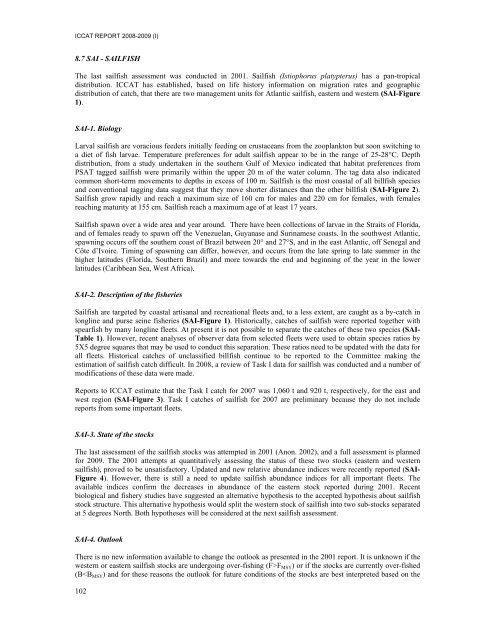REPORT OF THE STANDING COMMITTEE ON RESEARCH ... - Iccat
REPORT OF THE STANDING COMMITTEE ON RESEARCH ... - Iccat
REPORT OF THE STANDING COMMITTEE ON RESEARCH ... - Iccat
Create successful ePaper yourself
Turn your PDF publications into a flip-book with our unique Google optimized e-Paper software.
ICCAT <strong>REPORT</strong> 2008-2009 (I)8.7 SAI - SAILFISHThe last sailfish assessment was conducted in 2001. Sailfish (Istiophorus platypterus) has a pan-tropicaldistribution. ICCAT has established, based on life history information on migration rates and geographicdistribution of catch, that there are two management units for Atlantic sailfish, eastern and western (SAI-Figure1).SAI-1. BiologyLarval sailfish are voracious feeders initially feeding on crustaceans from the zooplankton but soon switching toa diet of fish larvae. Temperature preferences for adult sailfish appear to be in the range of 25-28°C. Depthdistribution, from a study undertaken in the southern Gulf of Mexico indicated that habitat preferences fromPSAT tagged sailfish were primarily within the upper 20 m of the water column. The tag data also indicatedcommon short-term movements to depths in excess of 100 m. Sailfish is the most coastal of all billfish speciesand conventional tagging data suggest that they move shorter distances than the other billfish (SAI-Figure 2).Sailfish grow rapidly and reach a maximum size of 160 cm for males and 220 cm for females, with femalesreaching maturity at 155 cm. Sailfish reach a maximum age of at least 17 years.Sailfish spawn over a wide area and year around. There have been collections of larvae in the Straits of Florida,and of females ready to spawn off the Venezuelan, Guyanase and Surinamese coasts. In the southwest Atlantic,spawning occurs off the southern coast of Brazil between 20° and 27°S, and in the east Atlantic, off Senegal andCôte d’Ivoire. Timing of spawning can differ, however, and occurs from the late spring to late summer in thehigher latitudes (Florida, Southern Brazil) and more towards the end and beginning of the year in the lowerlatitudes (Caribbean Sea, West Africa).SAI-2. Description of the fisheriesSailfish are targeted by coastal artisanal and recreational fleets and, to a less extent, are caught as a by-catch inlongline and purse seine fisheries (SAI-Figure 1). Historically, catches of sailfish were reported together withspearfish by many longline fleets. At present it is not possible to separate the catches of these two species (SAI-Table 1). However, recent analyses of observer data from selected fleets were used to obtain species ratios by5X5 degree squares that may be used to conduct this separation. These ratios need to be updated with the data forall fleets. Historical catches of unclassified billfish continue to be reported to the Committee making theestimation of sailfish catch difficult. In 2008, a review of Task I data for sailfish was conducted and a number ofmodifications of these data were made.Reports to ICCAT estimate that the Task I catch for 2007 was 1,060 t and 920 t, respectively, for the east andwest region (SAI-Figure 3). Task I catches of sailfish for 2007 are preliminary because they do not includereports from some important fleets.SAI-3. State of the stocksThe last assessment of the sailfish stocks was attempted in 2001 (Anon. 2002), and a full assessment is plannedfor 2009. The 2001 attempts at quantitatively assessing the status of these two stocks (eastern and westernsailfish), proved to be unsatisfactory. Updated and new relative abundance indices were recently reported (SAI-Figure 4). However, there is still a need to update sailfish abundance indices for all important fleets. Theavailable indices confirm the decreases in abundance of the eastern stock reported during 2001. Recentbiological and fishery studies have suggested an alternative hypothesis to the accepted hypothesis about sailfishstock structure. This alternative hypothesis would split the western stock of sailfish into two sub-stocks separatedat 5 degrees North. Both hypotheses will be considered at the next sailfish assessment.SAI-4. OutlookThere is no new information available to change the outlook as presented in the 2001 report. It is unknown if thewestern or eastern sailfish stocks are undergoing over-fishing (F>F MSY ) or if the stocks are currently over-fished(B
















